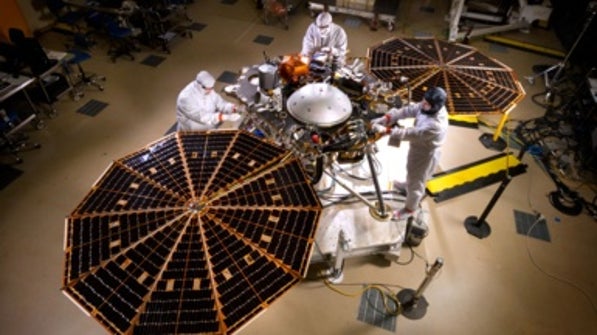
A planetary stethoscope will soon be on its way to listen to the heartbeat of Mars.
On 5 May, NASA plans to launch its US$994-million InSight spacecraft from Vandenberg Air Force Base in California. The mission’s main job will be to place a seismometer on the Martian surface and listen to seismic waves pinging around the planet’s interior.
If the effort succeeds, it will mark the first unequivocal detection of tremors known as marsquakes—and explain long-standing mysteries about the planet’s inner structure and how it evolved. “There are all these questions about Mars that can only be answered with seismic data,” says Bruce Banerdt, a geophysicist at NASA’s Jet Propulsion Laboratory in Pasadena, California, and the mission’s principal investigator.
“It will be the first geophysical observatory on Mars,” adds Ana-Catalina Plesa, a planetary geophysicist at the German Aerospace Center (DLR) in Berlin. “We are all really excited.”
Ears to the ground
On Earth, seismologists use networks of measuring stations scattered around the world to detect seismic waves from distant earthquakes. By tracking how that energy bounces around the planet’s interior, researchers can calculate fundamental information such as the size of Earth’s core.
But no one has yet done this on Mars. NASA tried unsuccessfully with its twin Viking landers, which launched in 1975. The seismometer aboard Viking 1 failed when an uncaging mechanism could not unlock the instrument. The seismometer on Viking 2 gathered about 2,100 hours of data—but all the tremors it detected, with one possible exception1, were caused by gusts of wind shaking the spacecraft. The seismometer had been mounted on top of the lander rather than in direct contact with Mars's surface.
After InSight lands, it will plop its watermelon-sized seismometer—built by the French space agency CNES—onto the Martian ground. The instrument will nestle beneath a protective wind shield as its three delicate pendulums measure the tiniest of tremors. “It is pretty much the most sensitive seismometer that’s ever been built,” says Renee Weber, a planetary scientist at NASA’s Marshall Space Flight Center in Huntsville, Alabama.
But constructing such a finicky instrument wasn’t easy. InSight was originally slated for launch in March 2016, but leaks in the vacuum seal that encloses the seismometer caused a 26-month delay. The enclosure has since been redesigned and the seismometer has been successfully tested at a geophysical observatory in southern Germany.
Martian mystery
The big question is how many marsquakes it will capture. With no actual data on Martian seismicity, researchers have used maps of geological faults on the planet’s surface2, along with calculations of how its interior cooled over time3, to estimate that Mars probably has fewer quakes than Earth but more than the Moon. (Robotic lunar landers, plus instruments deployed by astronauts from NASA’s Apollo programme, have measured shallow moonquakes caused by tectonic fractures and deep moonquakes caused by Earth’s tidal pull.)
InSight will land in Elysium Planitia, a safe and flat—but geologically boring—site near the Martian equator4. There, it might expect to measure one local marsquake each year with a magnitude between 2.7 and 4.2, says Weber. But it could also detect bigger marsquakes from distant regions more than 1,000 kilometres away, such as the fault-riddled Cerberus Fossae5 or the Tharsis area, with its enormous volcanoes. “Our goal is to collect something like 30 quakes over the mission,” says Philippe Lognonné, a geophysicist at the Paris Institute of Earth Physics who leads the seismometer team.
The bigger the marsquake, the more it will reveal about the planet’s interior, because only the largest seismic events penetrate all the way to the core. “A magnitude 7 would be great,” says Weber. InSight might see one or two quakes this big during the two Earth years that NASA hopes to operate the mission.
Core of the matter
Data from marsquakes will help InSight to map the boundaries between Mars’s crust, mantle and core. Doing so could reveal the depth to which the planet’s primordial magma ocean once churned and whether Mars ever had anything resembling plate tectonics. Pinning down the size of the Martian core, thought to be roughly half as big as Earth’s, would reveal its density and composition 6. The planet’s internal layers represent a record of the first tens of millions of years of its existence, says Banerdt. And studying Mars’s interior might also help reveal the early history of our own planet, which probably experienced many of the same changes soon after it formed.
Meanwhile, a radio-science experiment on InSight will measure how the planet wobbles on its axis, as a way to further understand how big its core is. And a heat-flow probe, built by a team at DLR, will pierce up to 5 metres beneath the surface to measure how temperature changes over depth and time.
As long as it launches by 8 June, InSight will be able to land on Mars on 26 November and deploy its instruments within weeks. For Lognonné, who has been trying to get a seismometer to Mars for more than two decades, that day can’t come soon enough.
“I’ll be much more happy when I get the first data,” he says.
This article is reproduced with permission and was first published on April 26, 2018
Bagikan Berita Ini
















0 Response to "Mars Quakes Set to Reveal Tantalizing Clues to Planet's Early Years"
Post a Comment